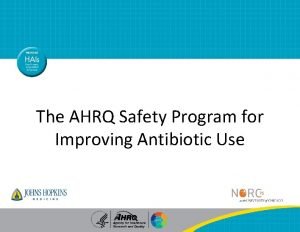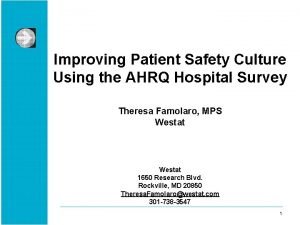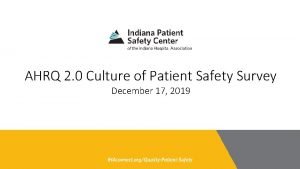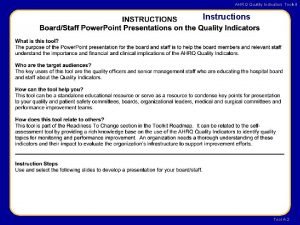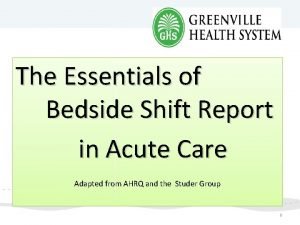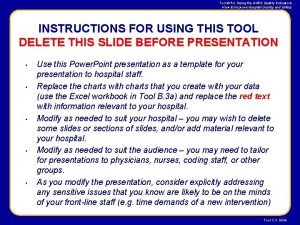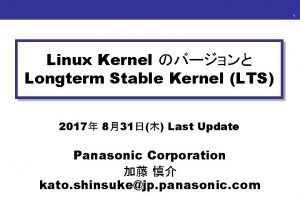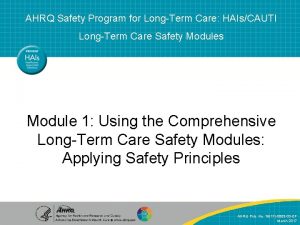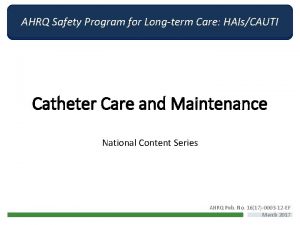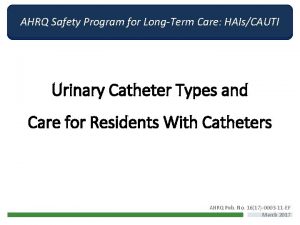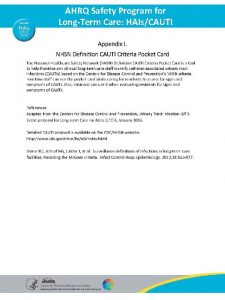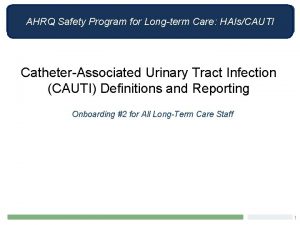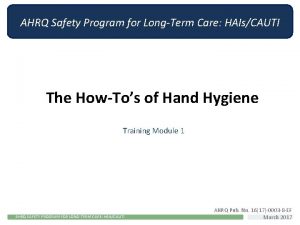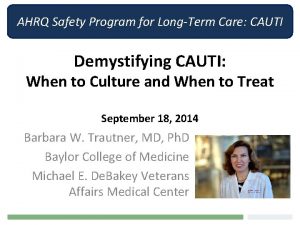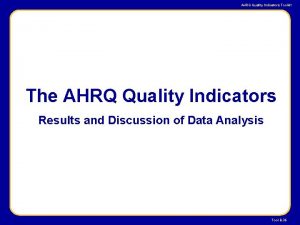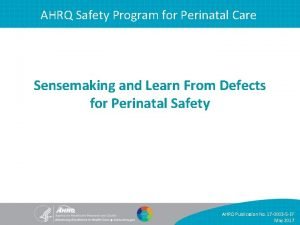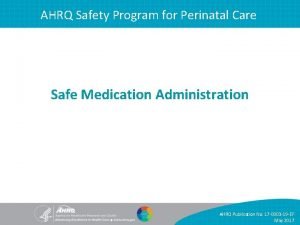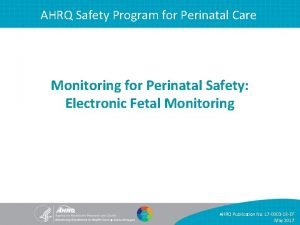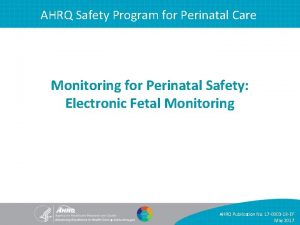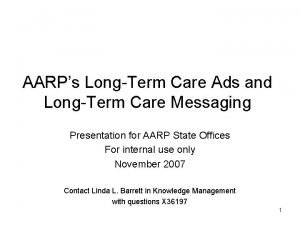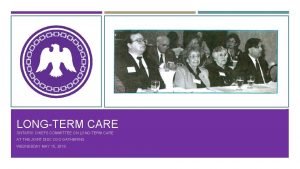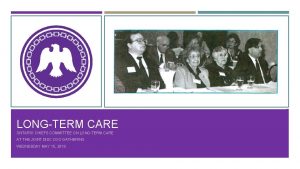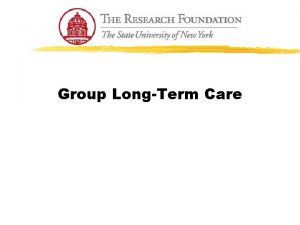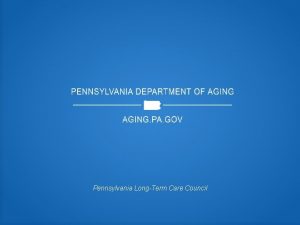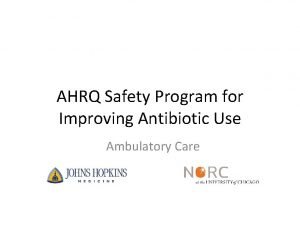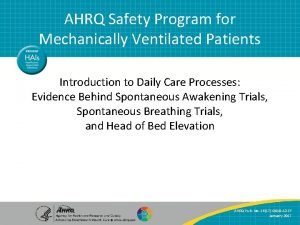AHRQ Safety Program for LongTerm Care HAIsCAUTI LongTerm






































- Slides: 38

AHRQ Safety Program for Long-Term Care: HAIs/CAUTI Long-Term Care Safety Modules Module 5: Resident and Family Engagement AHRQ Pub. No. 16(17)-0003 -03 -EF Resident and Family Engagement March 2017|

Objectives • Define resident- and family-centered care • Describe the key concepts of resident- and familycentered care in long-term care (LTC) facilities • Explain the importance of engaging residents and family members • Describe different methods to engage residents and family members in safety initiatives, especially in the area of reducing infections due to urinary catheters • Discuss the roles of resident and family advisors and LTC ombudsman programs in nursing homes’ safety teams AHRQ Safety Program for Long-Term Care: HAIs/CAUTI Long -Term Care Safety Modules Resident and Family Engagement | 2

Resident- and Family-Centered Care AHRQ Safety Program for Long-Term Care: HAIs/CAUTI Long -Term Care Safety Modules Resident and Family Engagement | 3

What Is Resident- and Family-Centered Care? 1, 2 • A philosophy that keeps the person, the resident and their family, at the center of every decision-making process • A focus assuring residents’ preferences are valued and respected • Care that reflects dignity and respect, information sharing, participation and collaboration AHRQ Safety Program for Long-Term Care: HAIs/CAUTI Long -Term Care Safety Modules Resident and Family Engagement | 4

What Does Person-Centered Care Look Like? 3 • Eliminating the assembly-line approach to care and embracing a philosophy of residents as individuals • Improving the quality of care and quality of life for residents by accommodating resident choices and preferences • Equipping staff with relevant knowledge and decision -making authority so they can effectively engage residents as partners in safety • Collaborating with resident advisors, advocates, and long-term care ombudsman programs at all levels AHRQ Safety Program for Long-Term Care: HAIs/CAUTI Long -Term Care Safety Modules Resident and Family Engagement | 5

Comparing Traditional Care to Person-Centered Care 1 Traditional Care Person-Centered Care Decisions about policies, procedures, and work environment are made exclusively by management. Management works with staff, residents, and family members to accommodate resident choice and preferences. Frontline staff are not involved in the decision-making process. Staff are empowered with relevant knowledge and included in the decision-making process. Traditional medical model where care Residents are given choice and input is driven by diagnosis, care tasks, and around their care and care plan based the individuals who perform the tasks. on their needs and preferences. AHRQ Safety Program for Long-Term Care: HAIs/CAUTI Long -Term Care Safety Modules Resident and Family Engagement | 6

Benefits For Residents and Families 1 • Having personal autonomy and the ability to direct care • Being offered choices that foster engagement and improve quality of life • Living in an environment that promotes trust and respect • Collaborating with staff who are attuned to resident preferences and needs and who will respond appropriately to the resident’s preferences • The opportunity to achieve the best quality of life possible AHRQ Safety Program for Long-Term Care: HAIs/CAUTI Long -Term Care Safety Modules Resident and Family Engagement | 7

Benefits for Staff 1 • Establishing better partnerships with residents and their families • Understanding resident preferences makes staff better equipped to anticipate resident and family needs and act accordingly • Feeling valued in person-centered care organizations AHRQ Safety Program for Long-Term Care: HAIs/CAUTI Long -Term Care Safety Modules Resident and Family Engagement | 8

Benefits for the Long-Term Care Facility 1 • Increased ability of staff to identify and respond appropriately to changes in a resident’s condition • Increased referrals from people who have a good experience and recommend the nursing home to others as a place for care • Increased staff retention due to a strong relationship between staff and residents AHRQ Safety Program for Long-Term Care: HAIs/CAUTI Long -Term Care Safety Modules Resident and Family Engagement | 9

Residents' Preference Satisfaction Interviews 4 • Use a preference collection tool to increase the facility’s understanding of what their residents desire for their care. • See the Advancing Excellence Campaign for more information on their Resident Preference Satisfaction Interview tool. AHRQ Safety Program for Long-Term Care: HAIs/CAUTI Long -Term Care Safety Modules Resident and Family Engagement | 10

Resident and Family Engagement AHRQ Safety Program for Long-Term Care: HAIs/CAUTI Long -Term Care Safety Modules Resident and Family Engagement | 11

What Is Resident and Family Engagement? 5 • Resident and family engagement— – Is an important component of person-centered care – creates an environment in which every team member, including the resident and their family, can work as partners to improve health care quality and safety. • Recognizes residents and family as — – Valuable members of the health care team AHRQ Safety Program for Long-Term Care: HAIs/CAUTI Long -Term Care Safety Modules Resident and Family Engagement | 12

Importance of Resident and Family Engagement 1 • Outcomes associated with enhanced resident and family engagement – higher resident satisfaction – better clinical outcomes – higher staff satisfaction AHRQ Safety Program for Long-Term Care: HAIs/CAUTI Long -Term Care Safety Modules Resident and Family Engagement | 13

How To Engage Residents and Families 5 • Establish positive relationships with residents and family • Focus on the needs and preferences of individual residents and family • Encourage resident and family participation in all decisions • Communicate that resident- and family-centered care is a priority at all levels AHRQ Safety Program for Long-Term Care: HAIs/CAUTI Long -Term Care Safety Modules Resident and Family Engagement | 14

Get to Know Your Health Care Team Tool AHRQ Safety Program for Long-Term Care: HAIs/CAUTI Long -Term Care Safety Modules Resident and Family Engagement | 15

Establishing a Relationship PLAY VIDEO: Video 1. 1: Staff Communication - https: //youtu. be/e. L 3 wo. SFbs. W 4 AHRQ Safety Program for Long-Term Care: HAIs/CAUTI Long -Term Care Safety Modules Resident and Family Engagement | 16

Understanding Resident Preferences 1, 5 • What are the resident’s likes and dislikes? • Does staff have the authority to do something about the residents’ preferences? • Are staff members allowed time to sit with residents and have meaningful conversation? AHRQ Safety Program for Long-Term Care: HAIs/CAUTI Long -Term Care Safety Modules Resident and Family Engagement | 17

Encourage Participation in Care Planning • Encourage residents and their families to participate in all aspects of care • Assess the residents’ preferences regarding their involvement • Listen for the needs and preference of residents and their families • Give residents and families access to information they need in a way they can understand it • Document specific preferences in care plans so resident preferences can be shared with all staff AHRQ Safety Program for Long-Term Care: HAIs/CAUTI Long -Term Care Safety Modules Resident and Family Engagement | 18

Communication and Engaging the Family PLAY VIDEO: Video 1. 2 Communication and Engaging the Family - https: //youtu. be/U 3 gy. L_p 7 Fy. A AHRQ Safety Program for Long-Term Care: HAIs/CAUTI Long -Term Care Safety Modules Resident and Family Engagement | 19

Listening to the Resident and Family • Ask about and listen to the resident and family’s needs and concerns – Use open-ended questions – Listen to, respect, and act on what the resident and family say – Help residents articulate concerns – Get a translator’s assistance if the resident or family member cannot understand you (e. g. , speaks primary language other than English) – Share specific preference information with everyone on the care team AHRQ Safety Program for Long-Term Care: HAIs/CAUTI Long -Term Care Safety Modules Resident and Family Engagement | 20

Explaining Care Plans • Help the resident and family understand health concerns, care plans and next steps in their care – Take every opportunity to educate the resident and family by giving timely and complete information in a way they can understand it – Share information using language or tools that resident can understand – Invite the resident or family to take notes and ask questions – Follow up with the resident and family to see if they understood the information or have additional questions AHRQ Safety Program for Long-Term Care: HAIs/CAUTI Long -Term Care Safety Modules Resident and Family Engagement | 21

Explaining Care Plans PLAY VIDEO: Video 1. 3 Communication in Action - https: //youtu. be/cav. Aprw. Me. G 0 AHRQ Safety Program for Long-Term Care: HAIs/CAUTI Long -Term Care Safety Modules Resident and Family Engagement | 22

Explaining How We Are Changing To Improve Care 6 • Residents and their family members need to know what changes are coming, when the changes will be implemented, and how these changes may impact services and routines • Staff can also discuss how change can be difficult and that all improvements involve some change AHRQ Safety Program for Long-Term Care: HAIs/CAUTI Long -Term Care Safety Modules Resident and Family Engagement | 23

Questions That You Answer 6 • • WHY are you making these changes? HOW will the changes impact the entire facility? HOW will the changes impact me, as a resident? HOW will the changes impact me, as a family member? • WHEN will the changes be implemented? AHRQ Safety Program for Long-Term Care: HAIs/CAUTI Long -Term Care Safety Modules Resident and Family Engagement | 24

Communication Tools 6 • Newsletter articles • Town hall meetings • Resident or family council meetings • Care conferences • Posters • Individual meetings • Local newspaper or TV news station stories AHRQ Safety Program for Long-Term Care: HAIs/CAUTI Long -Term Care Safety Modules Resident and Family Engagement | 25

New Ideas for Communicating 6 • Ask frontline staff to introduce the project through word, song, dance, drama, etc. • Put explanations in bills or other family or resident mailings • Create talking points to help staff respond to questions about any changes AHRQ Safety Program for Long-Term Care: HAIs/CAUTI Long -Term Care Safety Modules Resident and Family Engagement | 26

Resident and Family Engagement Checklist AHRQ Safety Program for Long-Term Care: HAIs/CAUTI Long -Term Care Safety Modules Resident and Family Engagement | 27

Challenges to Communication • It can be challenging to communicate with residents who may be hard of hearing or have dementia or language differences • It can also be difficult to communicate with family members due to logistical challenges, frequency of visits, or language differences • Staff can have challenges with communication due to limited experience, skills, or confidence AHRQ Safety Program for Long-Term Care: HAIs/CAUTI Long -Term Care Safety Modules Resident and Family Engagement | 28

How To Address Communication Challenges • Ask how the resident and family prefer to receive information • Use face-to-face communication to promote visual contact • Use written materials to provide residents useful content • Plan for repetition of the information in multiple interactions and formats • Use teach back to confirm understanding AHRQ Safety Program for Long-Term Care: HAIs/CAUTI Long -Term Care Safety Modules Resident and Family Engagement | 29

Engagement Using Resident and Family Advisers 7 • Residents and their family members can serve as advisors • Residents, family members, and prospective residents can serve on teams designated to improve resident experience, including resident safety • Resident and family advisors provide unique feedback, input, and perspectives that can help the facility and staff improve outcomes AHRQ Safety Program for Long-Term Care: HAIs/CAUTI Long -Term Care Safety Modules Resident and Family Engagement | 30

Resident and Family Advisers in Nursing Homes 7 • Are partners on teams developing or revising policies, procedures, and practices • Want to improve experiences for other residents and family members • Help facilities improve quality and safety by giving input and feedback • Can help identify changes that matter to other residents and family members and recognize the impact of changes in the facility on staff and residents AHRQ Safety Program for Long-Term Care: HAIs/CAUTI Long -Term Care Safety Modules Resident and Family Engagement | 31

Characteristics of an Engaged Adviser 7 • An engaged advisor will— – Listen – Share honest views – Draw on communication skills – Ask questions – Be ready for disagreements AHRQ Safety Program for Long-Term Care: HAIs/CAUTI Long -Term Care Safety Modules Resident and Family Engagement | 32

How To Work With Resident and Family Advisers 7 • Invite two or three residents and family members to a team meeting to discuss their experiences • Ask residents and families to give feedback on educational or informational materials • Invite residents and families to present at staff orientations and in-service programs • Explore the facility through the eyes of residents and their families by doing a “walk-about” with residents and families AHRQ Safety Program for Long-Term Care: HAIs/CAUTI Long -Term Care Safety Modules Resident and Family Engagement | 33

How To Work with Resident and Family Advisers PLAY VIDEO: Video 1. 4 Communication Tools - https: //youtu. be/ye 9 d 7 Uchm. RI AHRQ Safety Program for Long-Term Care: HAIs/CAUTI Long -Term Care Safety Modules Resident and Family Engagement | 34

Long-Term Care Ombudsman Program 8 • Long-term care ombudsman serve as advocates for residents of nursing homes and— – Help to resolve problems and assist with complaints – Educate LTC providers about residents’ rights and quality care practices – Advocate for residents' rights and quality care in nursing homes, personal care, residential care, and other long-term care facilities – Promote the development of citizen organizations, family councils, and resident councils • More information can be accessed on the National Long. Term Care Ombudsman Resource Center Web site. AHRQ Safety Program for Long-Term Care: HAIs/CAUTI Long -Term Care Safety Modules Resident and Family Engagement | 35

Key Concepts Review • Resident-centered care and effective engagement among residents and family members and care providers improves health outcomes and resident and family satisfaction • Advisors and long-term care ombudsman programs provide valuable insight about resident and family experiences and care delivery AHRQ Safety Program for Long-Term Care: HAIs/CAUTI Long -Term Care Safety Modules Resident and Family Engagement | 36

Tools • For staff, facilities, residents and families – Get to know your Health Care Team Tool – Resident and Family Engagement Checklist – Residents' Preference Satisfaction Interviews from Advancing Excellence in America’s Nursing Homes 4 – National Long-Term Care Ombudsmen Resource Center Web site AHRQ Safety Program for Long-Term Care: HAIs/CAUTI Long -Term Care Safety Modules Resident and Family Engagement | 37

References 1. 2. 3. 4. 5. 6. 7. 8. Bowers N, Nolet K, Roberts, E, et al. Implementing Change in Long-Term Care: A Practical Guide to Transformation. University of Wisconsin–Madison, School of Nursing; 2007. https: //www. nhqualitycampaign. org/files/Implementation_Manual_Part_1_Attachments_1_and_2. pdf. Accessed September 22, 2014. Institute for Patient and Family Centered Care. Bethesda, MD; December 2010. http: //www. ipfcc. org/faq. html. Accessed September 22, 2014. Love K. Person-Centered Care in Assisted Living: An Informational Guide. Center for Excellence in Assisted Living; June 2010. http: //www. theceal. org/component/k 2/item/644 -person-centered-care-inassisted-living-an-informational-guide. Accessed September 22, 2014. Advancing Excellence in America’s Nursing Homes. Person-Centered Care. Advancing Excellence in America’s Nursing Homes. https: //www. nhqualitycampaign. org/goal. Detail. aspx? g=PCC#tab 2. Accessed November 11, 2014. Frampton S, Gil H, Guastello S, et al. Long-Term Care Improvement Guide, Planetree, Inc: Derby, CT; 2010. http: //planetree. org/wp-content/uploads/2011/12/LTC-Improvement-Guide-For-Download. pdf. Accessed September 22, 2014. Turnham H. Resident and Family Centered Care. AHRQ Safety Program for Long-Term Care: CAUTI, July Content Webinar; July 2014. Patient and Family Engagement module, CUSP Toolkit. Rockville, MD: Agency for Healthcare Research and Quality; December 2012. http: //www. ahrq. gov/professionals/education/curriculumtools/cusptoolkit/modules/patfamilyengagement/index. html. Accessed September 22, 2014. National Long-Term Care Ombudsman Resource Center. About Ombudsmen. Washington, D. C. : National Long-Term Care Ombudsmen Resource Center. http: //www. ltcombudsman. org/aboutombudsmen. Accessed September 22, 2014. AHRQ Safety Program for Long-Term Care: HAIs/CAUTI Long -Term Care Safety Modules Resident and Family Engagement | 38
 Ahrq antibiotic stewardship
Ahrq antibiotic stewardship Ahrq safety culture survey
Ahrq safety culture survey Ahrq patient safety survey
Ahrq patient safety survey Ahrq quality indicators
Ahrq quality indicators Ahrq bedside shift report
Ahrq bedside shift report Ahrq quality indicators toolkit
Ahrq quality indicators toolkit Ahrq qi
Ahrq qi Linux kernel longterm
Linux kernel longterm Thomas silverstein
Thomas silverstein Qbs safety care
Qbs safety care Tertiary level of care
Tertiary level of care Fspos
Fspos Novell typiska drag
Novell typiska drag Nationell inriktning för artificiell intelligens
Nationell inriktning för artificiell intelligens Returpilarna
Returpilarna Varför kallas perioden 1918-1939 för mellankrigstiden?
Varför kallas perioden 1918-1939 för mellankrigstiden? En lathund för arbete med kontinuitetshantering
En lathund för arbete med kontinuitetshantering Särskild löneskatt för pensionskostnader
Särskild löneskatt för pensionskostnader Tidbok yrkesförare
Tidbok yrkesförare A gastrica
A gastrica Densitet vatten
Densitet vatten Datorkunskap för nybörjare
Datorkunskap för nybörjare Tack för att ni lyssnade bild
Tack för att ni lyssnade bild Tes debattartikel
Tes debattartikel Delegerande ledarstil
Delegerande ledarstil Nyckelkompetenser för livslångt lärande
Nyckelkompetenser för livslångt lärande Påbyggnader för flakfordon
Påbyggnader för flakfordon Arkimedes princip formel
Arkimedes princip formel Publik sektor
Publik sektor Jag har nigit för nymånens skära text
Jag har nigit för nymånens skära text Presentera för publik crossboss
Presentera för publik crossboss Vad är ett minoritetsspråk
Vad är ett minoritetsspråk Bat mitza
Bat mitza Treserva lathund
Treserva lathund Fimbrietratt
Fimbrietratt Claes martinsson
Claes martinsson Cks
Cks Byggprocessen steg för steg
Byggprocessen steg för steg Bra mat för unga idrottare
Bra mat för unga idrottare
